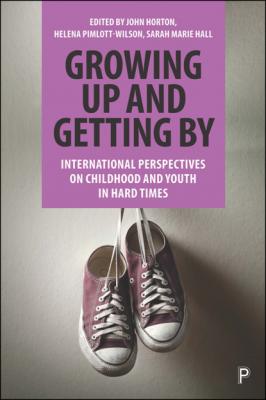Growing Up and Getting By. Группа авторов
Читать онлайн.| Название | Growing Up and Getting By |
|---|---|
| Автор произведения | Группа авторов |
| Жанр | География |
| Серия | |
| Издательство | География |
| Год выпуска | 0 |
| isbn | 9781447352945 |
5) Do any aspects of childhood and youth in COVID-19 times offer hope for more progressive and equitable futures?
Against these backdrops of entrenched economic crises, austerities and neoliberalisms it will be necessary for many of us to commit to renewed forms of community-mindedness, collegiality, care, support, activisms and progressive politics to safeguard the kinds of communities, spaces and precarious lives witnessed in the following chapters. And we want to conclude this chapter on a hopeful, affirmative note by asking: wherever and whenever you read this, can children and young people’s everyday hopes, solidarities and care offer hopeful ways forward in contexts of economic crises–austerities–neoliberalisms–COVID-19s? We want to recognise that, sometimes, children and young people can role-model hopeful and progressive ways of being in spite of the ‘hard times’ of COVID-19. In our own communities and lives, we have been struck by children and young people’s creativity, humour and play during this time, their community-minded actions, their intimate attunement to local spaces and natures, their gestures of inter- and intra- generational care, and their moral-political leadership in calling out issues of social and environmental injustice locally and globally. Maybe all of us could remember and learn from that …
As we prepare to submit this postscript, the COVID-19 situation continues to change daily, and will almost certainly have shifted further as the book goes to print, constituting new inequalities, new anxieties and new ‘hard times’…
References
Aalbers, M. (2009) ‘Geographies of the financial crisis’, Area, 41(1): 34–42.
Allen, K. (2016) ‘Top girls navigating austere times: Interrogating youth transitions since the “crisis”’, Journal of Youth Studies, 19(6): 805–820.
Askins, K. (2015) ‘Being together: Everyday geographies and the quiet politics of belonging’, ACME, 14(2): 461–469.
Barnett, C. (2005) ‘The consolations of “neoliberalism”’, Geoforum, 36(1), 7–12.
BBC (2020a) ‘Why are more people from BAME backgrounds dying from coronavirus?’, https://www.bbc.co.uk/news/uk-52219070
BBC (2020b) ‘A-levels and GCSEs: How did the exam algorithm work?’, https://www.bbc.co.uk/news/explainers-53807730
Bendit, R. and Miranda, A. (2015) ‘Transitions to adulthood in contexts of economic crisis and post-recession: The case of Argentina’, Journal of Youth Studies, 18(2): 183–196.
Blažek, J., Hejnová, T. and Rada, H. (2020) ‘The impacts of the global economic crisis and its aftermath on the banking centres of Europe’, European Urban and Regional Studies, 27(1): 35–49.
Brewer, M. and Handscomb, K. (2020) All together now? The impacts of the government’s coronavirus income support schemes across the age distribution, London: Resolution Foundation.
Brown, G. (2011) ‘Emotional geographies of young people’s aspirations for adult life’, Children’s Geographies, 9(1): 7–22.
Butler, J. (2009) Frames of war: When is life grievable?, London: Verso.
Cairns, D. (2017) ‘Migration and tertiary educated youth: A reflexive view of mobility decision-making in an economic crisis context’, Children’s Geographies, 15(4): 413–425.
Cairns, D., Growiec, K. and de Almeida Alves, N. (2014) ‘Another missing middle? The marginalised majority of tertiary educated youth in Portugal during the economic crisis’, Journal of Youth Studies, 17(8): 1046–1060.
Chadwick, R. (2017) ‘Thinking intersectionally with/through narrative methodologies’, Agenda, 31(1): 5–16.
Cloke, P., May, J. and Williams, A. (2017) ‘The geographies of food banks in the meantime’, Progress in Human Geography, 41(6): 703–726.
Crenshaw, K. (1991) ‘Mapping the margins: Intersectionality, identity politics, and violence against women of color’, Stanford Law Review, 43(6): 1241–1299.
Crescenzi, R., Luca, D. and Milio, S. (2016) ‘The geography of the economic crisis in Europe’, Cambridge Journal of Regions, Economy and Society, 9(1): 13–32.
Cross, M. (2013) ‘Demonised, impoverished and now forced into isolation: The fate of disabled people under austerity’, Disability & Society, 28(5): 719–723.
Crotty, J. (2009) ‘Structural causes of the global financial crisis: A critical assessment of the “new financial architecture”’, Cambridge Journal of Economics, 33(4): 563–580.
Derudder, B., Hoyler, M. and Taylor, P. (2011) ‘Goodbye Reykjavik: International banking centres and the global financial crisis’, Area, 43(2): 173–182.
Donald, B., Glasmeier, A., Gray, M. and Loboa L. (2014) ‘Austerity in the city: Economic crisis and urban service decline?’, Cambridge Journal of Regions, Economy and Society, 7(1): 3–15.
European Commission (2020) 2020 European semester: Country-specific recommendations, Brussels: European Commission.
Eurostat (2014) National GDP and unemployment accounts, http://ec.europa.eu/eurostat/data/database
Filho, G. and Neder, G. (2001) ‘Social and historical approaches regarding street children in Rio de Janeiro (Brazil) in the context of the transition to democracy’, Childhood, 8(1): 11–29.
Flesher Fominaya, C. (2020) ‘How austerity measures
